
Dental Cleaning
A professional dental cleaning procedure is an important part of the health care of all dogs & cats. More than 80% of dogs and cats over the age of 3 have some level of periodontal disease present (see separate entry on periodontal disease). Periodontal disease is maintained by a combination of regularly performed professional anesthetized dental cleaning procedures combined with home dental care. Every professional dental cleaning procedure involves the following process:
- Pre-anesthetic exam
- Pre-anesthetic testing
- Anesthesia
- Anesthetized oral exam
- Dental imaging
- Calculus removal
- Polishing
- Specific treatment
- Pain management
- Anesthetic recovery
- Follow-up oral care
Pre-anesthetic exam
A complete physical examination is performed to assess for any problems that could potentially affect anesthetic safety.
Pre-anesthetic testing
Because the professional dental cleaning procedure always requires general anesthesia, additional precautions are needed. Pre-anesthetic testing allows us to assess your pet’s health and to adjust the anesthetic protocol based on your pet’s individual needs.
Anesthesia
Every dental procedure in animals requires general anesthesia. Non-anesthetic or sedated dental cleaning procedures are ineffective, unsafe, or both. Because of this, anesthetic safety is of the utmost importance in the field of veterinary dentistry (see separate entry on anesthesia).
Anesthetized oral exam
During the dental procedure, a complete oral exam is performed to evaluate all aspects of the oral cavity.
Dental imaging
More than half of dental problems are present below the gum line. Dental imaging must be performed during every dental procedure. In most patients, imaging will be a combination of intraoral dental x-rays and 3-D imaging using cone-beam CT scan.
Calculus removal
The pet’s calculus (tartar) is removed from above and below the gum line, using an ultrasonic scaler and hand instruments.
Polishing
Scaling of the teeth results in microabrasions (small scratches) on the surface of the teeth and roots, which can contribute to future accumulation of calculus. Polishing the teeth results in a smoother surface and helps to reduce the rate of calculus accumulation
Specific treatment
After the teeth are evaluated and cleaned, the client is contacted to discussed any new problems that have been found, and specific treatment that is needed is performed.
Pain management
Dental cleaning procedures are not typically painful, unless additional dental treatment is needed. Pain management is an important part of any dental treatment that results in pain. Patients are given pain medication prior to the dental procedure, and local or regional nerve blocks are used. Your pet will also be prescribed one or more pain medications to be administered at home.
Anesthetic recovery
After the dental procedure is complete, your pet will be recovered in a quiet, comfortable enclosure. A licensed veterinary technician will remain with your pet until they are recovered from anesthesia and are in stable condition.
Follow-up oral care
After the procedure, you will be advised, both verbally and in writing, about appropriate aftercare, recommended dental maintenance procedures, and follow-up appointments or procedures. You will be given a phone number to contact us after-hours, in the event that you have any questions or concerns after your pet’s procedure.


